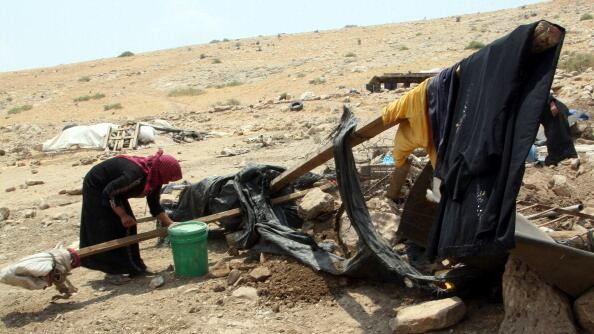On the first day of Rosh Hashana, Jews read a Torah portion centered around the birth of Isaac and the expulsion of Hagar and Ishmael from Abraham's camp. On the second day, we read about the binding of Isaac and hear the news of Sarah's death. According to rabbinic exegesis, these two stories are linked: Sarah hears and mistakenly believes that her son Isaac has died, and in that moment she has an inkling of what Hagar felt as the desert sun beat down upon her son Ishmael.
This story, with its emphasis on experiencing and understanding the pain of others' exile, should be one that is natural to the Jewish people. And yet, we seem to have gotten lost in the wilderness ourselves. We have forgotten the lessons of our own exiles.

This June, the New York Review of Books published an essay by David Shulman that begins by recalling the story of a (fictional) Palestinian village and the expulsion of its residents by Israeli soldiers. Shulman goes on to talk about his own experience in Susiya in South Hebron, where the 300 impoverished Palestinians who still live there have had demolition orders served to them by the Civil Administration. The orders call for the destruction of all village structures: tents, hunts, latrines, and a solar and wind turbine set up by Israeli activists three years ago. Shulman notes:
If the orders are carried out—this could happen at any moment—then it means the nearly complete destruction of an entire village and the violent expulsion of its people. They will be, quite literally, cast into the desert.
Reading this piece, the words "cast into the desert" struck me profoundly. The case of Susiya is representative of dozens of villages destroyed or under threat of destruction—meaning thousands of people who have been, or will be, cast into the desert—due to the asymmetric application of Israel’s Civil Administration to building permits in Area C. As B'tselem reported at the end of August, the Civil Administration withholds planning permits and uses demolition as a strategy to reduce the Palestinian presence in the area. An appeal was submitted in August, and Susiya's fate currently remains uncertain.
After Abraham offers Isaac to God on the mountain, he goes to Beer Sheva, apparently without Isaac. Sarah, too, appears to part ways with Abraham, since we are later told that he must travel to Kiryat Arba to bury her. These facts can be read as hinting that neither of them ever speaks to Abraham again. What’s more, the text suggests that Isaac is living in Be'er Lachai Ro'i, where Hagar had her divine encounter in the desert. It is possible that Hagar is still living there and that Isaac has gone to visit her following his mother's death. Finally, when Abraham dies, Isaac and Ishmael return to bury him. It is clear that while Ishmael and Isaac end up very different people, they bear one another no ill will. When the time comes to bury their father, they are able to do so together.
Although it is impossible to say for sure, maybe the reason God insisted that Abraham banish Hagar and Ishmael is because, if Isaac and Ishmael had stayed together, they would have been poisoned by the harsh relationship of their parents' generation. Instead, eventually, they are able to get beyond the conflict of their mothers and come together for an important event. And then they can go on leading their own lives, sharing the same land, but living apart.
In short, we have two very different models of "leaving." In the first model, the powerless family is expelled into the desert with a single waterskin, and is left to die. The second model is one of reconciliation: Hagar takes in the son of her old nemesis when his mother passes; his half-brother works with him to bury their father; perhaps they bury the hatchet as well.
In recent years, several articles from the right-wing have trumpeted the so-called morality of the settler movement, or at least predicted its triumph. We should not deceive ourselves: the settlers could very well succeed. This would be a tragedy for both Israel and the Palestinians. The "morality" of the settlers is to ignore the most important part of their birthright: the part that demands just treatment for all. Ironically, this can best be achieved not by sharing the land, but by dividing it into two states, one for each people. In this way, our fathers, Isaac and Ishmael, will both see their children thrive together.
We can choose whether the story is the one in which the status quo is maintained: in which settlers insist that the only possible act is to throw the servant girl and her child out into the desert while "papa" government backs them up, pouring millions of dollars into making sure they, like Hagar and Ishmael, get nothing but a single waterskin to sustain them. Or we can act God's part in this story, making the tragedy into a story of holiness and salvation: there is plenty of water, but Hagar and Ishmael need to go elsewhere to find it. The story of oppression can be replaced with one in which the mother of the child we fear can be counted upon to succor us when we look for help. But for this to happen, we have to grow up and take responsibility. If we can't come together to bury our fathers, then at least we can bury the hatchet.
On this Rosh Hashana, a time of contemplation and judgment of national sins, we must seek the path of reconciliation so that no one else will be cast into the desert.






